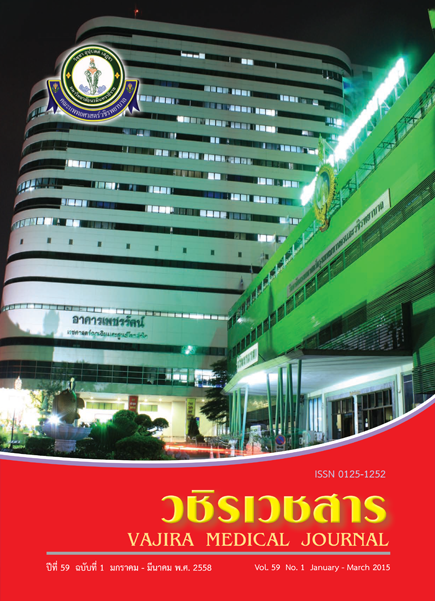Dermatology Life Quality Index in Thai Dialysis Patients with Cutaneous Manifestations: A Cross-Sectional Study and Review
Main Article Content
Abstract
Objectives: End-stage renal disease (ESRD) patients who are on dialysis usually have cutaneous changes in multiple aspects such as pruritus, dry skin and hyperpigmentation. These symptoms usually lead to psychological distress and are sometimes neglected by dermatologists and nephrologists. The aim of our study is to evaluate dermatologic-specific, health-related quality of life (QoL) of Thai ESRD patients who are on hemodialysis (HD) or continuous ambulatory peritoneal dialysis (CAPD) and have cutaneous symptoms at Vajira Hospital.
Methods: A cross-sectional study was done during August 2014 at Vajira Dialysis Unit. ESRD patients who are on HD or CAPD and have cutaneous symptoms were enrolled. The patients were fully examined by the dermatologist. Patient’s demographic data and cutaneous manifestations were recorded. The validated Thai version of the Dermatology Life Quality Index (DLQI) questionnaires were used for evaluation of QoL of the patients.
Results: Of 77 patients enrolled, 37 were females and the rest were males. The mean (SD) age at evaluation time was 57 (±15) years. The prevalence of abnormal cutaneous manifestations was 100%. The most common abnormality was xerosis (100%), followed by pruritus (94.8%), and hyperpigmentation (49.4%). The mean disease duration of dialysis (SD) before evaluation was 4 years. The mean total DLQI score was 4.74 (±2.58), and there was no statistical significance between patients who underwent CAPD compared to those with HD. However, the clinical intensity of xerosis was a significant prognostic factor for DLQI worsening (r=0.639, p<0.0001), and a significant correlation between pruritus intensity and the impairment of DLQI (r=0.764, p<0.0001) was also demonstrated.
Conclusion: The impact of abnormal cutaneous abnormalities in dialysis patients on dermatologic-specific, health-related QoL were high, especially xerosis and pruritus which appears to be underestimated in clinical practice. More careful treatment of these symptoms should not be abandoned to improve the QoL on dialysis patients.


